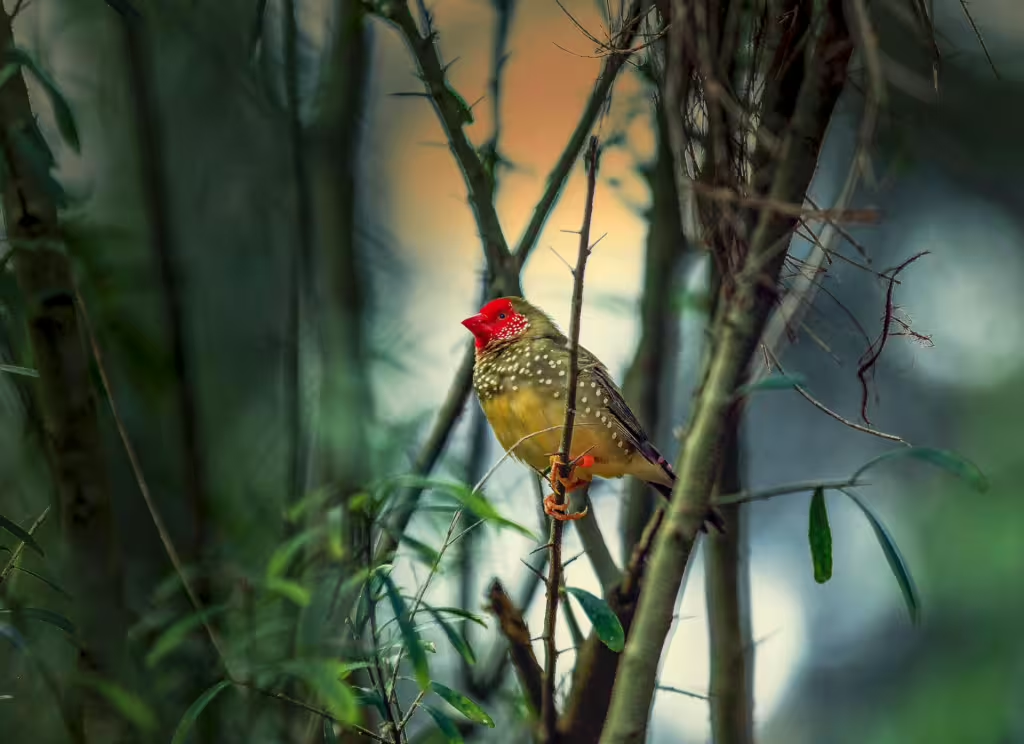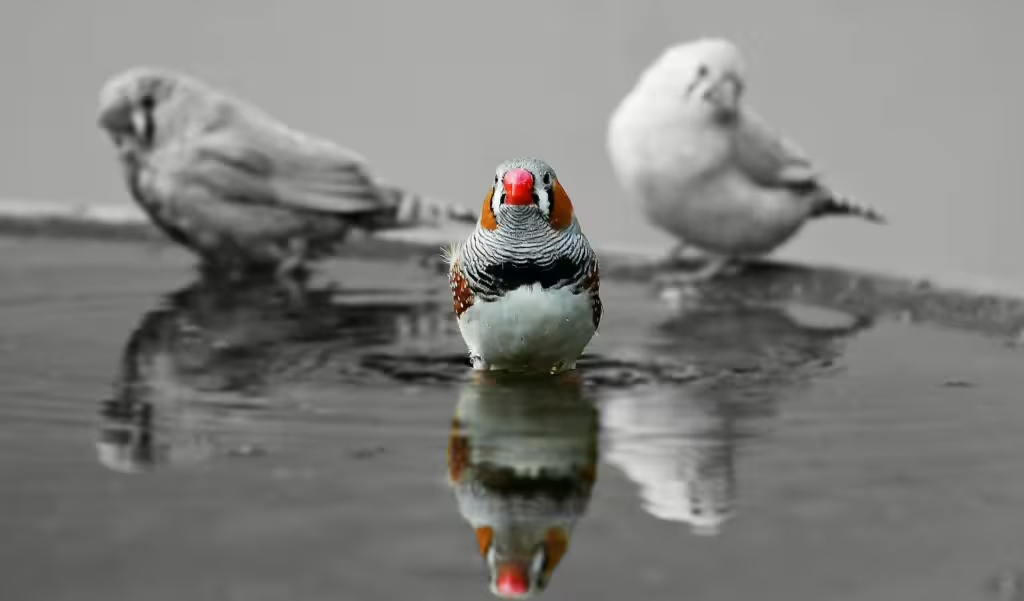Finches, what might seem like an innocuous group of birds with what many might mistakenly believe is a minimal impact upon their respective ecosystems. After all, how important could a handful of songbirds really be? The answer, to the absolute astonishment of many readers is; very important!
When we talk about finches, we are discussing a specific group of small to medium-sized passerine birds. In the annals of scientific history, finches are most well known for their diversity and adaptability. Though they can be found across the globe in a variety of habitats, the most famous finches are those found in the Galápagos Islands. This group of finches, in particular, were first popularized in the mid 1800s, when naturalist Charles Darwin first noticed their unique adaptations.
Indeed, Darwin’s encounter with finches during his 1835 visit to the Galápagos Islands is considered something of a turning point in scientific history. The famous naturalist noticed that each island seemed to host slightly different species of finches, each with unique beak shapes and feeding habits. These subtle differences helped him formulate his theory of natural selection, which has become a cornerstone of modern scientific thinking. The suggestion that species could adapt over generations in response to environmental pressures was groundbreaking and has altered science as we know it. Even today, Darwin’s finches remain a textbook example of adaptive radiation—a process in which organisms diversify rapidly to exploit different ecological niches.
Their status as symbols of adaptation is partly why we chose finches for this article, in the first place. Even in other ecosystems outside the Galápagos exhibit a remarkable range of sizes, colors, beak shapes, and behaviors. While these birds are beautiful and fascinating in their own right, they are also important ecological players. Finches act as seed dispersers, insect controllers, and even pollinators in some regions. Their presence and population dynamics are often used as indicators of environmental health. By studying finches across continents and climates, the scientists of today continue to gain insights into biodiversity, adaptation, and conservation.
In this article, we will journey across forests, islands, deserts, and grasslands to meet the most amazing finch species on the planet. So get ready to go on an amazing journey in the same vein as the one Charles Darwin took all those years ago.

Darwin, Evolution, and the Galápagos Finches
As we mentioned earlier, Charles Darwin visited the Galápagos Islands during his 1835 voyage on the HMS Beagle. He was not there to enjoy the tropical sunshine, he was there to learn everything he could about the nature of well…nature. As he journeyed across the island chain he encountered a group of finches that would eventually become pivotal to the development of his theory of natural selection. This was not a Sir Isaac Newton and the apple moment, however. Darwin didn’t immediately grasp the significance of the finches, though he did notice the similarity of the birds in terms of general appearance. It wasn’t until later that he noticed the subtle differences in appearance of finches from different islands, particularly in terms of beak shapes and feeding habits.
As a matter of fact, it was ornithologist John Gould who later identified these birds as a closely related group of species. These “Darwin’s finches,” as they are now known, exemplify a concept known as adaptive radiation: the diversification of a group of organisms into forms filling different ecological niches. The variations in their beaks are adaptations to specific diets, such as seeds, insects, and even blood from seabirds.
Even today, centuries later, the story of the Galápagos finches remains one of the most compelling illustrations of evolution in action.
A Global Look: 15 Finch Species Around the World
While Darwin’s finches are iconic in their own right and are certainly worthy of further examination, the finch family is far more vast and varied than that. Finches span multiple genera and can be found on many different continents. Below is a sampling of 15 fascinating finch species, each with its own unique traits and ecological niche.
Medium Ground Finch (Geospiza fortis)
- The first example, unsurprisingly, is found in the Galápagos Islands. We picked it because, in many ways, this species was central to Darwin’s observations. It has a robust beak that is best suited for cracking seeds.
Large Cactus Finch (Geospiza conirostris)
- This cactus-dwelling finch also hails from the Galápagos. It is possessed of a long, pointed beak ideal for feeding on cactus fruits and flowers.
Woodpecker Finch (Camarhynchus pallidus)
- Another Galápagos native, the woodpecker finch uses twigs or cactus spines as tools to extract insects from tree bark. This is a remarkable example of tool use in birds that is not usually seen outside of parrots and corvids.
Zebra Finch (Taeniopygia guttata)
- Our first non Galápagos finch is native to Australia. This species is widely studied in laboratories but is best known for its melodic song and monogamous pairing.
European Greenfinch (Chloris chloris)
- Found throughout Europe, the European Greenfinch sports vibrant green plumage and a stout beak ideal for cracking open seeds.
House Finch (Haemorhous mexicanus)
- Originally from the southwestern U.S. and Mexico, the House Finch has adapted in real time in many ways. It has evolved to live in and around urban environments and now spans much of North America.
Purple Finch (Haemorhous purpureus)
- Known for its raspberry-colored males, this North American finch is a forest dweller that feeds on a steady diet of seeds and berries.
Common Chaffinch (Fringilla coelebs)
- As the name suggests, the Common Chaffinch is ubiquitous across Europe. Many would recognize this finch by its melodic song and vibrant plumage, at least in males of the species.
Hawaiian Honeycreeper (Various species within subfamily Drepanidinae)
- Once grouped with finches, these native Hawaiian birds evolved from a common finch ancestor, though they are actually considered part of a subfamily by current zoological thinking. Hawaiian Honeycreepers display remarkable beak diversity, as some feed on nectar while others have adapted to feed primarily on insects.
Crimson Finch (Neochmia phaeton)
- Native to northern Australia and New Guinea, the crimson finch is known for its vivid red plumage. It has a preference for wet grasslands, making it unique among finches that seem to prefer more arboreal habitats.
Asian Rosy Finch (Leucosticte arctoa)
- The Asian Rosy Finch is a high-altitude species that lives in alpine regions of Central and East Asia. It has a stout body and a constitution that allows it to live well in colder climates.
Eurasian Bullfinch (Pyrrhula pyrrhula)
- Found across Europe and Asia, the bullfinch is one of the most famous finch species in terms of non-finch enthusiasts. It has a distinctive black cap and a soft, whistling call.
American Goldfinch (Spinus tristis)
- Known for its bright yellow summer plumage, this finch is a frequent visitor to gardens and feeders across the United States. Like some finches on this list, the American Goldfinch is a mainstay of temperate habitats and vital for seed distribution, as well as insect control.
Black Rosy Finch (Leucosticte atrata)
- The Black Rosy Finch is a rare species that is found only in the Rocky Mountains. Luke the Asian Rosy Finch, this bird thrives in cold, alpine environments.
Java Sparrow (Padda oryzivora)
- Although not a true finch taxonomically, this species of bird is often grouped with them due to similar morphology and behavior. Native to Indonesia, it quite popular in the pet trade. Finch breeding for pets is quite common amongst bird enthusiasts, the only problems arise when wild birds are taken from their habitats rather than bred from existing captive “fancy” specimens.
The Science of Finch Evolution
The diversification of finch species, especially Darwin’s finches, provides scientists with a natural laboratory for studying evolution. These days, modern research has even taken to using genomic analysis. These methodologies have revealed how gene flow, hybridization, and environmental pressures contribute to speciation in certain animals. For instance, a famous long-term study on Daphne Major Island has shown how droughts and food availability can shift the dominant beak size in populations within just a few generations.
In addition, the genes responsible for beak development, such as ALX1 and BMP4, have since been identified as key players. Changes in these genes lead to significant morphological differences that can determine which birds survive under which environmental conditions; even when those conditions vary over time.

Conservation and Climate Change
Despite their uniqueness and environmental importance, many finch species are under threat thanks to human beings. Like so many species, finches are threatened by the lethal combination of habitat loss, invasive species, and climate change. In the Galápagos, specifically, introduced species such as rats and parasitic flies (e.g., Philornis downsi) have managed to pose severe threats to endemic species for the better part of the past few centuries and native finches are not immune. These invasive predators are preying on eggs and nestlings just as much as they do on iguanas, boobies, and other native animals.
Elsewhere, agricultural expansion, urbanization, and pesticide use have diminished suitable habitats for finches. Even ubiquitous, common species like the Eurasian bullfinch and American goldfinch have been affected. Climate change is also shifting the range and food sources of many species, potentially leading to mismatches in breeding timing and resource availability for many finch species.
Nevertheless, conservation efforts are being undertaken on behalf of the finches. These efforts include habitat restoration, captive breeding, and stringent biosecurity measures, especially in island ecosystems. Sadly though, even these efforts might prove moot if we, as a species, don’t change our environmentally-destructive ways.
Why Finch Diversity Matters
As you have already seen, finches are more than just colorful songbirds. Each and every one of these birds are vital components of their ecosystems. Some of them help to control insect populations, others disperse seeds, and even a few of them help to pollinate plants. Their varied behaviors, ecological roles, and evolutionary histories provide essential insights into biodiversity and the adaptability of life.
Part of the reason that finches are endangered by human-derived environmental factors, is that they are particularly sensitive to environmental changes. This makes them adaptable but also, in scientific terms, useful bioindicators. Their population trends can signal shifts in habitat quality, climate conditions, or the presence of pollutants. Conservation biologists often monitor finch species to assess the health of an ecosystem and guide habitat restoration efforts. Finches remind us of the dynamic nature of evolution and the importance of protecting the environments that foster such diversity.

True Investigator Says…
As you can see, finches are amazing creatures; birds whose adaptive nature and environmental importance are often overlooked due to their size and semi-innocuous nature. Despite the curveballs that nature and indeed, humanity have thrown at them, finches continue to adapt, thrive, and inspire in many places. Birdwatchers, scientists, nature lovers, and animal enthusiasts can all agree that these feathered marvels offer humanity a window into the evolutionary forces that shape all life on Earth. As we do our best to continue to conserve their habitats and understand their stories, finches continue to remind us that even the smallest beak can tell a world-changing tale.
The finches’ resilience in the face of changing environments, predators, and food sources speaks to the incredible power of natural selection and evolution in practical terms. Watching a finch crack open a tough seed or extract insects from bark is akin to witnessing millions of years of evolution in action; and it is likely what inspired Charles Darwin and his ilk in the first place. Yet it isn’t just their amazing adaptations that give us pause. Their songs, so varied and melodious, serve as mating calls or territorial signals, reminding us of the deep connections that exist between various species, their fellow avians, and their habitats.
In many ways, finches can also serve as ambassadors for broader environmental awareness. When we protect the forests, islands, and grasslands that finches call home, we also safeguard countless other organisms that share in those ecosystems; sometimes even ourselves. And as you have seen, in learning about these birds, we gain more than knowledge—we gain perspective on the delicate, interconnected web of life that sustains us all.
Discover more from TrueInvestigator
Subscribe to get the latest posts sent to your email.


